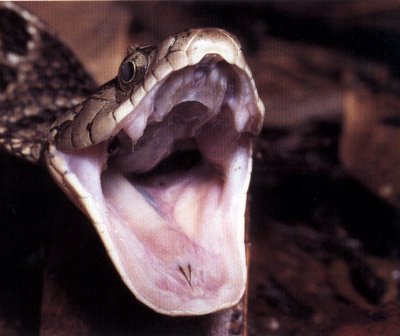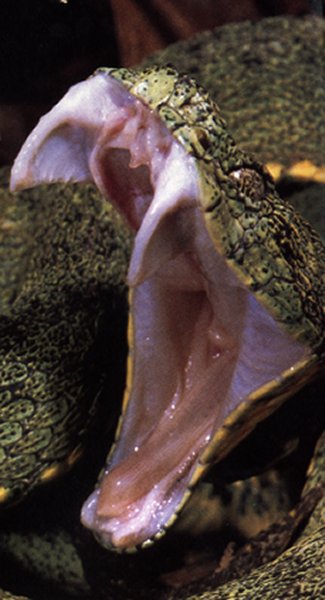

So what is venom, how did snakes get it and why do they have it? These are questions that have interested herpetologists and other scientists alike.
Venom itself is a poison secreted by animals for either defensive or offensive purposes. Venom originated from digestive enzymes that were originally located in the stomach. Throughout the millions of years it has progressed quite a lot and in some animals has become quite different from it's origin.The type of venom depends on the type of animal. In spiders venom is kept rather simple. It is pretty much just digestive enzymes. Spiders use their venom to turn their hard shelled insect meals into nice and nutritious goo. So in a sense one can think of this type of venom as a form of starting the digestive process before you even start to eat the meal.
In insects venom is used predominantly as a defensive weapon. Wasps, bees and ants use formic acid in their stings to cause a painful burning sensation that will either kill or injure their enemy enough to make them think twice about attacking them again.Amphibians all use their venom for defense. In amphibians the venom is secreted through glands in the skin to make the animals unpalatable.
So as we can see venom is a predominantly defensive adaptation. An adaptation that has found it's way into every class of vertebrates except one. The birds; the only class to forego any venom.In mammals we have platypi with venomous claws, then there are the fish which comprise too many venomous species to count and finally we have the reptiles.
All venomous reptiles are squamates and of them snakes make up the bulk. There are only two species of venomous squamates that are not snakes, the lizards of the genus: Heloderma. These lizards use their venom for defense as well and can deliver powerful and painful bites.
In snakes venom has found a new use, for offense. Since snake prey generally has the advantage of speed (not to say that snakes can't be speedy. A black mamba traveling at 17 mph is nothing to sneeze at.) snakes had to find a new way to take down their prey without running the risk of losing them or getting too hurt in the process. Enter venom, a fast and effective mode of subdueing prey items with minimal risk to the snake.
Venom types
Snake venom can be divided into two broad (yet fuzzy) categories. That of hemotoxicity and neurotoxicity.
Hemotoxic venom effects the blood and organs, causing a breakdown or inflammation in the body. Hemotoxic bites are the most painful as breathing hurts and tissues start to die.
Neurotoxic venom, as the name suggests, effect the nervous system, leading to everything from siezures to death. Neurotoxic bites are the most deadly.Although we have these two wonderful different categories, no snake fits completely in each. Many snakes incorporate both neurotoxic and hemotoxic venom in their bites so when telling them apart one goes by which type is more predominant.
For instance Ophiophagous hannah (King Cobra) has predominantly neurotoxic venom while Crotalus adamanteus (Eastern diamondback rattlesnake) has predominantly hemotoxic venom.False venom glands (a misleading name no doubt) are made up either from mucus producing supralabial glands that run on either side of the head extending as a continuous strip from near the snout to below and well behind the eye. These then lead to several ducts that lead to the bases of many maxillary teeth. Alethinophidians are known to have this type of arrangement.
Most colubrids have a different arrangement. Rather than use those modified salivary glands they use a larger gland known as the Duvernoy's gland. This gland is situated right under the skin, above and near the angle of the jaw. These glands open from a duct at the base of one or more posterior usually enlarged fangs that may or may not be grooved. These glands do not have a lumen (central storage chamber) so the snakes must give off a continous stream of venom into their prey which means that they must continue to hold on to the animal to ensure envenomation.
True venom glands are made uf thick connective tissue. They contain a lumen, a separate compressor muscle and a duct connecting them to a single fang on each side of the jaw. These glands dominate all elapids and viperids (along with some atractaspidids)
Methods of Delivery
Their are four main types of teeth in snakes with which venom is transferred from gland to prey. While these forms seem to indicate a continual progression towards more complexity, they are misleading as it doesn't take into account the morphological variation in snake dentitions making for a paraphyletic occurence (that is they all thought up different ways to accomplish the same goal).

Interestingly enough fixed fanged elapids are known to hold onto their prey after biting. This would seem to present a potential hazard for the snake, but the predominantly neurotoxic venom works so fast that the prey doesn't have enough time to struggle, thus ensuring the snake it's meal.
Some cobra types such as the rinkhals (Hemachatus haemachatus) and many species of Afro-Asian cobras (Naja sp.) have the ability to spit their venom at predators. Their fang tips have beveled, circular (sometimes pear shaped) apertures on the anterior surface just above the tip where the venom is ejected. African spitters go one stepped further. They have spiral grooves in their fangs that (like the riflings of a gun barrel) force a spin on the venom allowing for greater accuracy.This is only used in defense and is amazing effective as these snakes are adepth marksmen. By expending venom in these little droplets, the snake is guaranteed the maximum use of it's (normally offensive) venom when battling a predator. How often can these snakes spit before running out. Well one black necked spitting cobra (Naja nigricollis) emptied it's venom glands by spitting fifty seven times in only twenty minutes. Truly a force to be reckoned with.

Viperids have predominantly hemotoxic venom and as such, their bites take longer to take effect. Since the effect is longer, the snake can't risk holding onto the struggling prey for it would surely get hurt, but with their potent venom, quick strikes and hyperextendable fangs, these snakes are able to get in and out extremely fast. Not only can the fangs hyperextend (up to 1800) but with the separately jointed maxillae the fangs can move individually as well. So a viper can decide whether or not to move one fang or two. Inject one side or two. The amount of venom control in vipers is astounding as well as their venom reservoirs. The bulk of Bitis gabonica's head is it's venom glands. Shocking!
Offense or Defense
As stated before, snakes predominantly use their venom to capture prey, but when push comes to shove, venom can mean the difference between life and death.
For a venomous snake, biting a predator means wasting precious venom; a commodity that doesn't come without it's price. Venom costs energy to make and takes a while to refill when empty. A snake would much rather save that venom for something worth it like food, so it takes quite a bit of pressing to get a venomous snake to actually bite. In fact it is for these reasons that venomous snakes have adopted so many warning strategies. From warning colors, to hoods, to rattles, venomous snakes do everything in their power to avoid biting the enemy. In contrast a boid or other constrictor will readily bite in defense. While they lack venom, recurved teeth can be just as bad and since constrictors don't have to worry about wasting venom they can feel free to bite all they want.
Lethal injection or False alarm?
Along with warning well in advance, another common thing found in venomous snakes (especially viperids) is giving what is known as a "dry bite."
If bitten make sure to ID the snake. Remember as much as possible about it. For an idea of the type of venom that might have been injected in you consider the area that you are at and how the snake looked. Vipers, due to their large venom glands, have heart shaped heads. Elapids have nice thin heads. Colubrids are harder to tell apart from elapids, but a venomous elapid will give warning or have some type of forewarning available. Colubrid bites normally don't kill and are more a pain than anything else. Viper bites can be deadly and normally are very painful. Elapid bites are extremely lethal and antivenin treatment is a must if bitten.
Although all this seems scary, it's best to remember that no venomous snake will attack without severe provocation. Look for the warning signs and watch where you step and you should be fine. Also remember many bites given are dry, so just because you were bitten doesn't mean you were envenomated. A good rule of thumb when dealing with a scared or cornered snake is that the last thing it's going to want to do is bite.